
12 minute read
A Nepal Rotary club does a transformational project
Rasheeda Bhagat
Can you imagine human beings who cannot have a bath even once a year simply because they do not have the luxury of water available to do so? Nor can they wash their clothes. Appalling, isn’t it? But the 1,363 people of an entire village in Nepal, called Pere, situated at an altitude of 11,000ft above sea level, faced exactly this plight, till Rotary came into their lives.
Advertisement
In March 2022, Rotary Club of Mahabouddha, RID 3292, in Kathmandu did almost the
When we chose this village, several members expressed doubts saying this place is so difficult to reach, how will you monitor and execute the work.
Devraj Ghimire
Project contact impossible in this village, by bringing piped water supply to all the 236 homes, and really transformed the villagers’ lives. But to be able to have water in their homes, to regularly bathe, wash their clothes, cultivate their land and grow and consume crops, rather than just roots, have given the villagers more than dignity… it has given them hope, and dream of a much better future.
So and so, when PDG Ganesh Bhat from RI District 3170, a TRF cadre of technical advisors for South Asia, was recently sent to Pere village to assess and evaluate the Rotary global grant project valued at $196,000, a young lad asked him about the possibility of pursuing education beyond Class 10.
Children who rarely went beyond their homes have now started to go to the village school, after taking a bath and neatly dressed in clean, washed clothes. When the young boy asked the Rotarian “how to study beyond Class 10”, the teacher standing close by observed: “The very fact that he is asking such a question shows that Rotary has given them hope, hope of a better future.” For till then, all that the boy could think of was studying up to Class 10.
Before diving into details about this unique project which has worked on almost all the focus areas of Rotary — WinS, literacy, water and sanitation, health and hygiene, enhancing livelihoods — to find out more about Pere village, which can be reached from Kathmandu only after two domestic flights and a rickety 4-hour drive on a
dangerously narrow road, Rotary News reached out to former president of RC Mahabouddha, Devraj Ghimire, who has worked very hard on this project.
Asked why his club had chosen this remote village which is so difficult to access, he said: “In our District 3292, the terrain is hilly and places are difficult to reach. So most of the Rotary clubs here choose projects in villages which are close by. Our club, with 42 members, is a very active and dynamic club, but when we chose this village, several members expressed doubts saying this place is so difficult to reach, how will you monitor and execute the work.”
The background of how this Kathmandu club got a Rotary club in Switzerland as an international
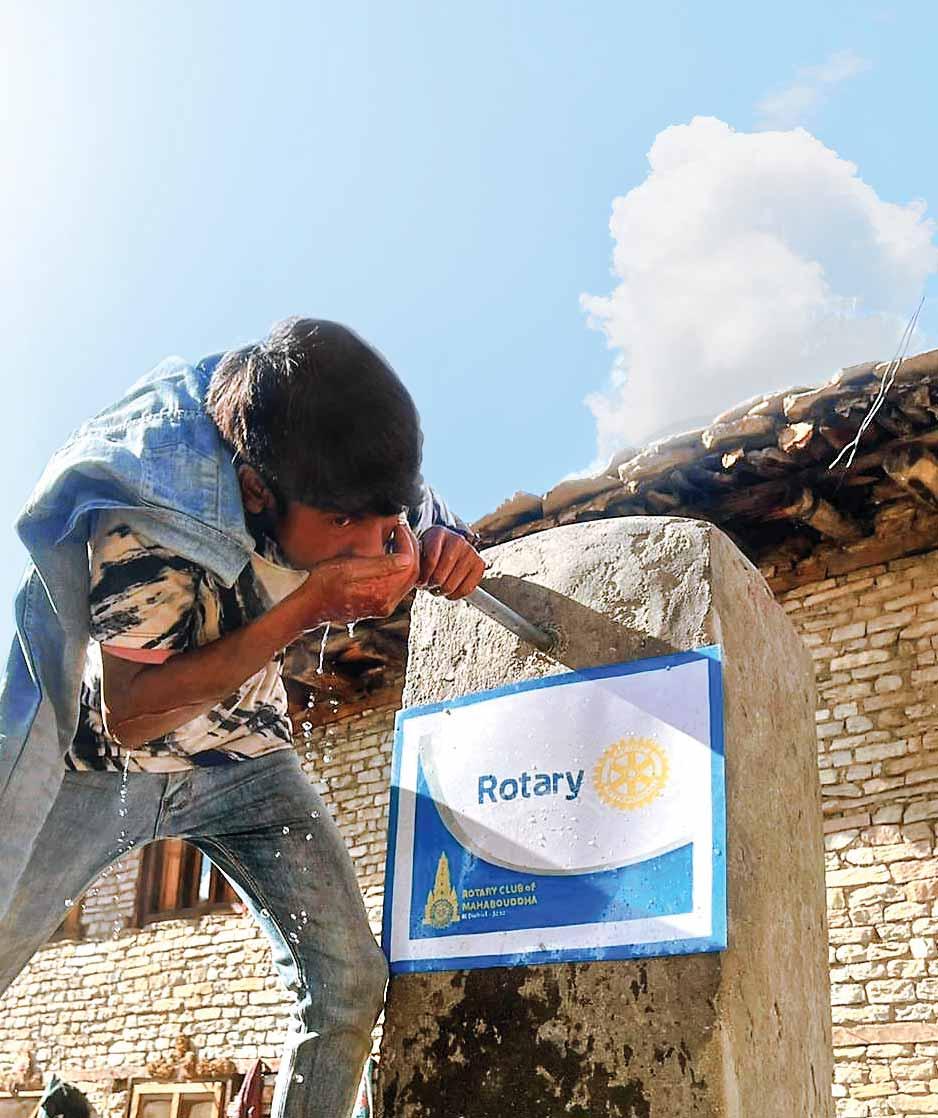
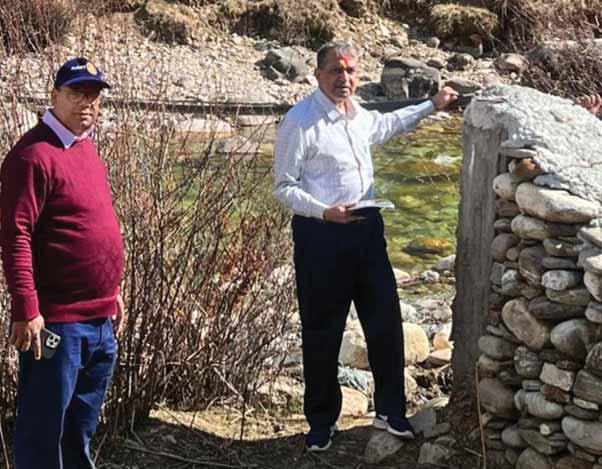
PDG Bhat with past president Devraj Ghimire (L) at the construction site of the water tank.
partner for this global grant of $196,000, is an absorbing story of how remote connections materialise, when good things are meant to happen. “We have a friend in Switzerland, Alex Zahnd, who was a visiting professor of Kathmandu University. He had taught in a technical college in Jumla many years ago. But we kept in touch with him and would call him to our club meetings as a speaker when he was in Nepal,” says Ghimire.
Prof Zahnd was very friendly with these Rotarians
The villagers didn’t have water even to clean themselves after
defecating in the fields. and it was he who had told them about Pere village and how those villagers desperately needed help. After the professor returned to Switzerland, RC Mahabouddha’s Rotarians reached out to him seeking his help in connecting them to a Rotary club in Switzerland whose members would be willing to partner with them in doing a transformational project in Pere.
In the meanwhile, they also tried to get a partner in the US and Australia. But the Swiss partnership came through. About 3–4 years ago, after Prof Zahnd had told the club members about the plight of the villagers of Pere, “we had gone there with some food and clothes and seen the pathetic conditions under which they lived. We had then decided that if we want to really do a service project to change the life of a
TRF Cadre member PDG Ganesh Bhat inspecting the project site in the village. community, this was the village where we should do it,” says Ghimire.
RITS Nepal, a non-profit organisation with expertise in water and hygiene-related projects, was the perfect fit as a partner as “they have experience in executing such projects, and they’ve already done a small hydro power project in a nearby district, and are also doing a greenhouse project in the neighbouring villages.”
The Rotarians found that the villagers’ biggest difficulty was to get water for drinking, cooking and washing. Even though there is a river flowing through the village, thanks to its location at 11,000ft above sea level, it remains frozen through the year.
Had you come here earlier, we wouldn’t even be able to talk to you, needing to stand at least 15–20 metres away from you, because you wouldn’t have been able to bear the stench.
As told by a villager to PDG Bhat
There is a water spring situated in the hills at a height of 200 metres, which is about 2km away from the village, and from here the villagers were bringing barely 3–4 pots of water for their daily household use. Open defecation was the norm, and water scarcity was so severe that the villagers didn’t have water even to clean themselves after defecating in the
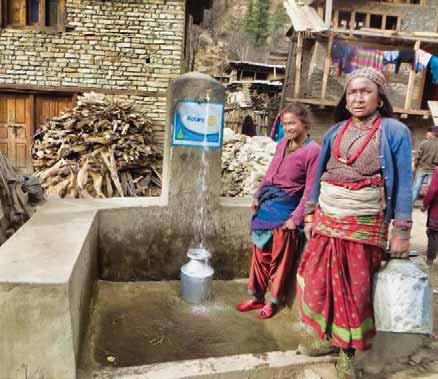
fields. Small wonder that they hadn’t even heard of a toilet, or what it is used for. With such appalling hygiene and paucity of safe drinking water, disease was rampant in the village.
But then as the project work began in this village two years ago, the Rotary magic started unravelling. In March 2022, when PDG Bhat, a Rotary cadre member, reached the village after a harrowingly long travel — two flights from Kathmandu and then a 4-hour drive on a dangerously narrow road, “where most of the
Thanks to this project, the villagers now have clean, filtered drinking water, and are regularly using toilets, and there is absolutely no open defecation.
Ganesh Bhat
member, TRF Cadre of Technical Advisors time Vidya, my wife, and I were so terrified that we kept our eyes closed, as our jeep bumped every few minutes,” — it was a group of happy villagers who greeted him.
The first thing one of the leaders told him was that “had you come here earlier, we wouldn’t even be able to talk to you, needing to stand at least 15–20 metres away from you, because you wouldn’t have been able to bear the stench. But now, thanks to clean water available in our homes, we are able to take regular
(Seated first row, from R) RITS Nepal head Ram Raje Singh, Rtn Rajaram Luitel and PDG Bhat with the villagers.
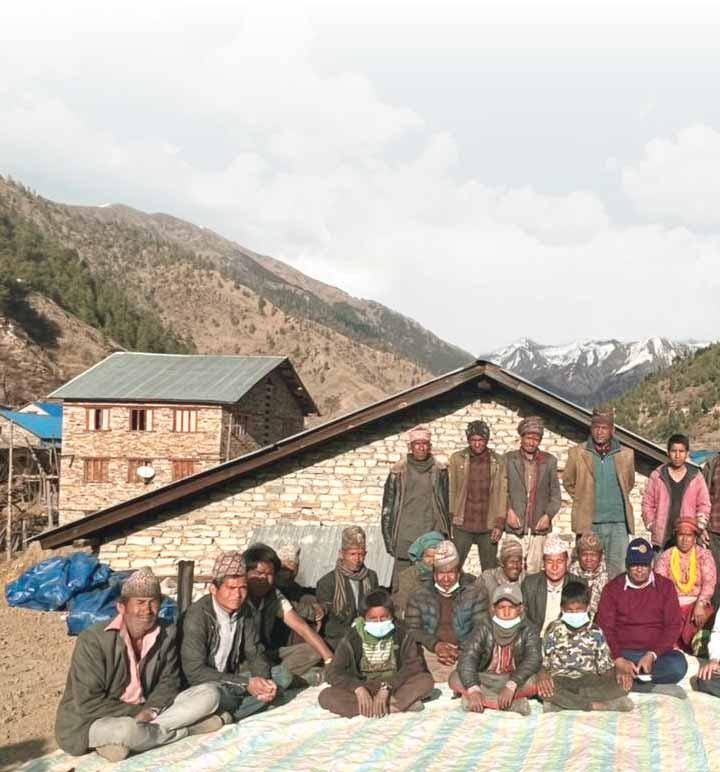
baths, and wash our clothes,” recalls Bhat.
Describing this as one of the “10 best and most effective Rotary projects ever done anywhere in the world,” Bhat, a structural engineer, said thanks to this project “the villagers now have clean, filtered drinking water, and are regularly using toilets, and this includes small children, so there is absolutely no open defecation, and they now live under clean and hygienic conditions. I saw a water tap in front of each house, toilets near their homes, and a water filter inside every house.”
With water now available for farming — the villagers have to take permission from the local village leaders and pay a small fee for water drawn for farming — they have now started growing vegetables and fruits on their own land. Earlier, they consumed mostly potatoes and other roots. The deserted village school has sprung back to life, as children have returned to school, and slowly the literacy levels will improve.
Bhat who is preparing an evaluation report for TRF regarding the manner in which the global grant money was used, is all praise for the quality of the civil engineering and other work done by Nepal RITS.
To fetch water to this village, this project tapped the spring from which the villagers were bringing pots of water to their homes. Near the spring, a small water tank with adequate filters and a capacity to store 1,500 litres of water was constructed. About 50 metres away, a larger tank (12,000 litres capacity) was constructed and the two were connected. The larger tank can take care of the villagers’ water needs for two days. Both the tanks are made from RCC. From the larger tank a pipeline running over the frozen river was taken right up to the village and water connections given to each home… really, and in all senses of the word a dream come true for the villagers.
Also, 236 toilets have been built which means one toilet for
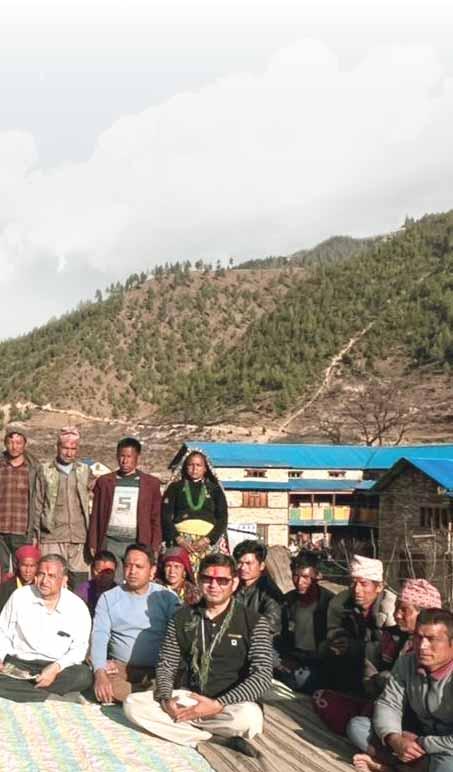
We are now building for them solar water bath cabins; separate for men and women.
Devraj Ghimire

Women in Pere village learn to wash their hands. power system is being put in place for these cabins,” says Ghimire.
PDG Bhat says that during his visit, when he held a community meeting to find out how this project has changed their lives, “the women told me that earlier the men never went out for work, and the children too stayed at home as nobody went to school. Most of the people were sick all the time due to the unhygienic conditions in which they lived, the poor quality water they consumed, etc. But now, for the last six months, they have been getting clean, filtered drinking water, their health has improved and farming has once again begun.”
With water now being available, the farming practices have gone one notch higher. Compared
each home (the population of the village is 1,363), and this for residents who “did not even know what a toilet looks like or is used for.” Once the villagers started washing and bathing, and had sufficient clean water for drinking and cooking, the project planners decided to go one step further. “We are now building for them solar water bath cabins; separate for men and women. The solar
236 toiletshave been
built, and this for residents who did not even know what a
toilet looks like or is used for.
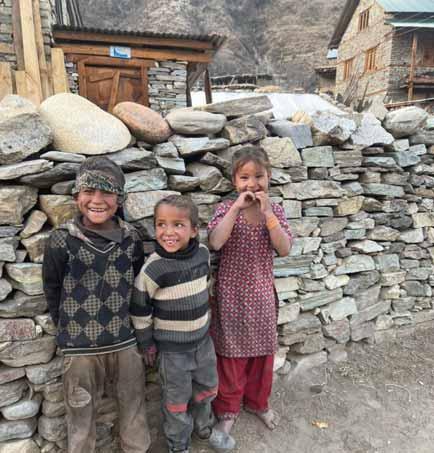
PDG Bhat on the job at a project site.
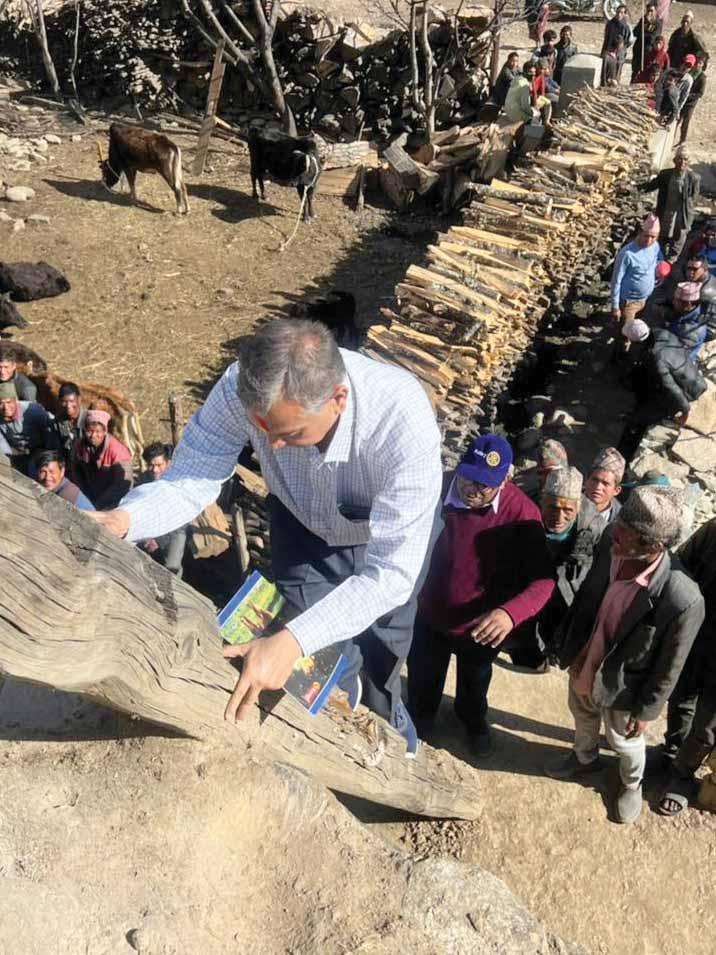
to only roots and tubers that the villagers were consuming for dearth of water to grow anything else, the villagers are now growing both fruits and vegetables, by using water with the village council’s permission and paying a token fee for it.
Even after putting up the solar bath cabins, this GG will have a balance of Nepalese `42 lakh “and I have suggested that the water pipeline, which has been put above and across the frozen river, with a width of over 150 metres, should be supported by intermediate stone pillars, and covered properly from the top,” says Bhat. He says that if the pipeline is not supported properly, the pipes may crack after some time.
He stayed in the village to evaluate this project for four days. The inspection and examination done by this structural engineer was so thorough that he got the odd “toilet excavated to check the depth, what kind and quality of construction material they have used, whether it is safe and according to prescribed specifications,” he adds.
That a lot of thought and detail has gone into the project can be gauged from the fact that the villagers have been trained how to use and clean the toilets; how to wash their hands with soap; how to brush their teeth with toothpaste and brush. A couple of people have been trained on how to repair or replace the pipeline in case of any cracks, how to replace the taps, and given important knowhow on how to have twin pits in the toilets so that when one fills up the other can be used, while the first one is dried and cleaned. The water filters for drinking water, given to each home have been designed by RITS Nepal, and have three different layers of sand through which the
PDG Bhat interacting with a woman.
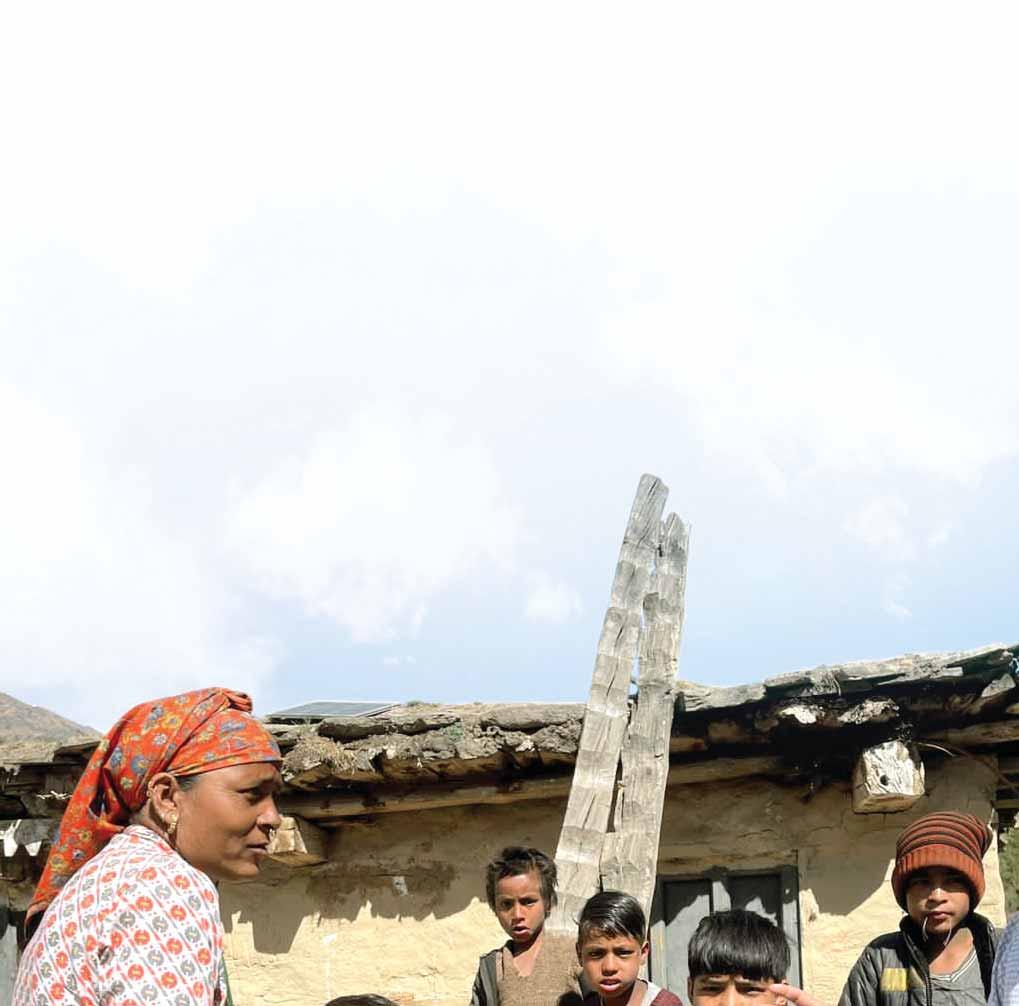

water is filtered before it dispenses through the tap. The villagers have also been taught how to clean the sand filters and replace them every three months, so that they continue to get clean drinking water.
Next comes the sustainability part. During his visit, a Rotary Community Corps was also set up for the village and the president and secretary selected.
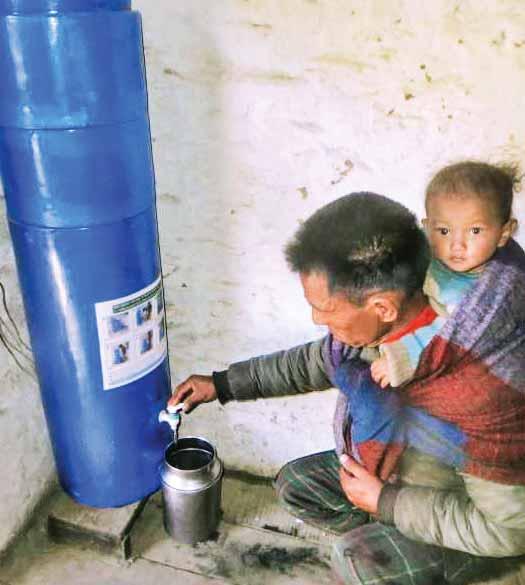
The club has distributed water dispensers to the village homes.
This RCC will be monitored and guided by the Rotary team from RC Mahabouddha. Ghimire, who works as the chief administrative officer in a college in Kathmandu, adds that his club is determined to make this project sustainable, and in December “along with some experts, we will do some research to find out what kind of difference this project has made in the lives of the villagers and how sustainable it is.” The club has raised and set aside some money to ensure that the facilities provided are maintained properly, and repair work done periodically.
Even after this project is completed, he and his team from this 42-member club in Kathmandu will continue “working with that community to bring a meaningful and everlasting change. We also want to plant many trees in that village,” he adds. The chairman of the village council wants a vocational training course for the villagers and has sought the Rotarians’ help for a course.
For Bhat, the young boys’ words will be difficult to forget; “he asked me: Sir, can you help us find a way to pursue further education after Class 10. This shows that Rotary has given him and others hope of a better tomorrow.”
Designed by Krishnapratheesh S







